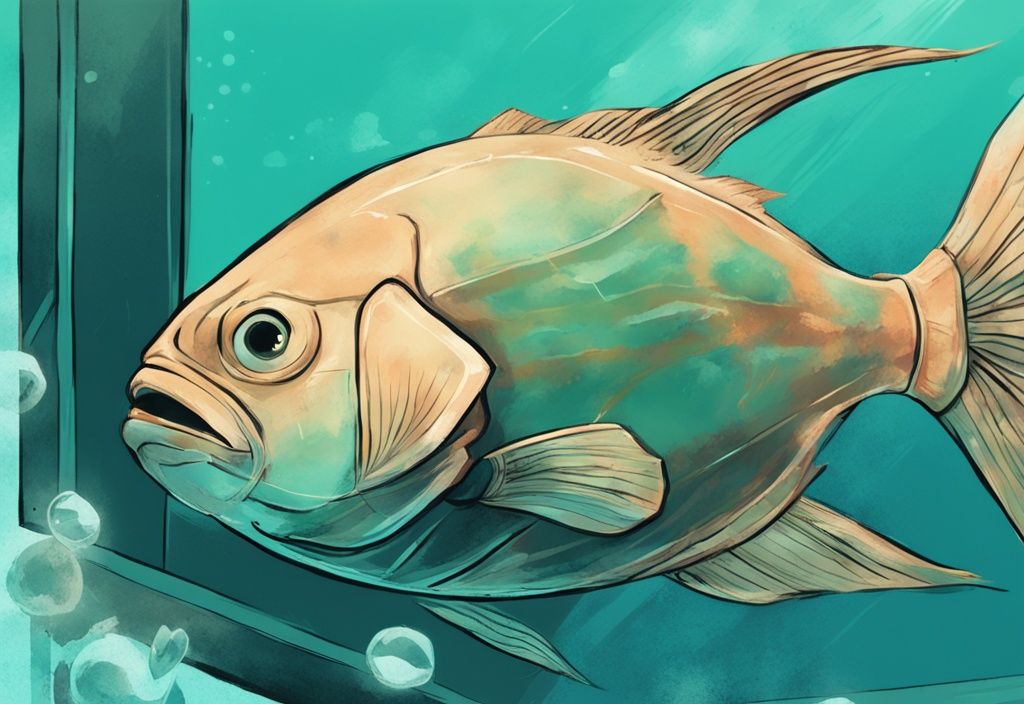Do you find it puzzling to see your fish lying at the bottom of the tank? Well, you’re not alone. As a marine biologist, I’ve spent over two decades observing and analyzing such behaviors in a variety of marine species. Trust me, understanding why your fish is laying at the bottom can reveal critical insights into their health and overall well-being.
In this article, we will explore the many reasons – from normal habits to potential environmental issues or even stress – that can cause your fish to spend prolonged periods at the tank bottom. With this knowledge, we can better identify any potential issues, improve the tank conditions, and put into place preventive measures that keep your aquatic pets healthy and thriving.
Ready to dive in? Let’s unravel the mystery behind your fish’s intriguing behavior together. With just a few expert tweaks to your aquarium care, you can ensure a vibrant and balanced ecosystem that serves as a safe haven for your underwater friends.
Key Reasons Your Fish Might Rest At The Tank Bottom
Understanding Normal Fish Behavior
Certain species of fish are naturally inclined to stay at the tank’s bottom. Fish such as catfish, loaches, plecos, and Otocinclus Catfish have evolved as bottom-dwellers, often scavenging the substrate for residues and searching for food.
Even typically energetic fish may choose to rest at the bottom during their downtime between active periods.
As fish age, they may exhibit increased resting behavior due to reduced energy levels, which is a normal part of their aging process.
Additionally, newly introduced fish often stay at the bottom of the tank. This initial behavior is generally attributed to anxiety and acclimation stress, but they usually settle and become more active over time.
Identifying Environmental Issues Affecting Your Fish
The quality of the tank’s environment plays a crucial role in fish health and behavior.
Poor water quality, characterized by elevated levels of ammonia, nitrites, or nitrates, can stress fish, prompting them to seek refuge at the bottom where they might feel safer.
Similarly, an improper temperature within the tank can force fish to the bottom—either seeking warmth or cooler conditions based on the discrepancy.
Low oxygen levels at the surface can lead fish to stay at the lower regions where they might find slightly more dissolved oxygen.
Incorrect pH balance could also push fish to areas they perceive as more stable.
Moreover, high currents within the tank can tire fish more quickly, causing them to settle at the bottom away from the intense flow.
Stress Triggers Affecting Your Fish
Several stressors can significantly affect fish behavior, often resulting in them resting at the tank bottom.

Aggressive tank mates can intimidate less dominant fish, forcing them to retreat to the bottom for safety.
Overcrowding and territorial disputes further exacerbate stress levels, leading fish to seek sanctuary at the tank’s lower levels.
Physical injuries sustained from tank decorations or during conflicts with other fish can result in pain and stress, making the tank bottom a preferable resting spot.
High-stress situations such as these not only affect the mood of the fish but also increase their vulnerability to illness, which could perpetuate the bottom-dwelling behavior.
Immediate Steps To Take When Your Fish Is Laying at the Bottom of the Tank
Picture this: you come home after a long day and find your fish sedentary at the bottom of the tank. You wonder, “why is my fish laying at the bottom of the tank?” This section will guide you through recognizing signs of stress, improving water quality, and ensuring proper tank temperature to address this issue.
Recognizing the Signs of Stress
Stress in fish can manifest in various ways. If you’re asking yourself, “why is my fish laying at the bottom of the tank,” observe for changes in color, clamped fins, or frequent hiding. Additionally, watch for unusual swimming patterns, a decline in appetite, and rapid breathing. Such signs might indicate underlying stress or health problems. Alarming symptoms like difficulty breathing, refusal to eat, or deviations from normal behavior demand immediate attention. Recognizing these symptoms promptly can help pinpoint and address the root cause of your fish’s distress.
Improving Your Tank’s Water Quality
One key intervention for addressing the concern, “why is my fish laying at the bottom of the tank,” revolves around improving water quality. Regularly clean the tank substrate and décor to maintain a healthy environment. Consistent water changes and effective filtration are crucial in keeping ammonia, nitrite, and nitrate levels within safe limits. By ensuring these parameters are in check, you can reduce stress and create a more inviting habitat for your fish. Proper water quality is fundamental to preventing fish from lingering at the tank bottom.
Ensuring Proper Tank Temperature
Maintaining a consistent and appropriate tank temperature is essential in answering the question, “why is my fish laying at the bottom of the tank.” Each fish species has a specific temperature range they thrive in, and fluctuations can cause stress or health problems. Utilize proper tank heating equipment to avoid sudden temperature changes. Keeping the temperature stable ensures a comfortable environment for your fish, reducing the likelihood of them resting at the bottom due to temperature stress. A well-regulated tank temperature supports the overall well-being of your aquatic pets.
Health Concerns Related To Your Fish Laying at the Bottom
Questions around why your fish is laying at the bottom of the tank often circle back to underlying health concerns. Here, we explore some common reasons that may contribute to this behavior, spanning from nutritional deficiencies to serious diseases.
Common Nutritional Issues
One key reason why your fish might be laying at the bottom of the tank is poor nutrition. An improper diet can severely weaken fish, making them lethargic and more likely to rest at the tank’s bottom. Providing a well-balanced and nutrient-rich diet is crucial for maintaining fish vitality and energy levels.
Additionally, overfeeding can lead to poor water quality and digestive problems, compounding health issues. To prevent this, feed your fish controlled portions and remove any uneaten food promptly to maintain a clean and healthy tank environment.

Impact of Health Problems and Diseases
Various health problems and diseases can cause your fish to lay at the bottom of the tank.
Swim bladder disease is one such issue, often resulting from organ compression or digestive disturbances, which impairs the fish’s ability to maintain buoyancy.
Another common ailment is white spot disease, an infection that leads to stress and discomfort, forcing fish to seek refuge at the bottom. Furthermore, parasitic infections like ich and gill worms contribute significantly to this behavior, with symptoms including erratic swimming and visible signs like white spots on the fish’s body.
Understanding why your betta fish might be staying at the top of the tank can also provide insights into different behavioral patterns in fish.
Ammonia toxicity is another critical factor to consider when questioning why your fish is laying at the bottom of the tank.
Overpopulation, inadequate filtration, or poor cleaning practices can result in high ammonia levels, causing appetite loss, respiratory issues, and stress. Monitoring water quality diligently and ensuring a well-maintained tank can prevent such toxins from affecting your fish’s health.
Preventive Measures for Your Fish’s Health
Providing a balanced diet tailored to the specific fish species is crucial in ensuring your fish’s overall health and vitality. Proper nutrition supports their immune system and energy levels, which are essential to preventing them from spending too much time at the bottom of the tank. Overfeeding can deteriorate water quality and lead to digestive issues, increasing stress and the likelihood of diseases. Make sure to offer a varied diet that includes all necessary nutrients to prevent any nutritional deficiencies that could weaken your fish.
Creating an Ideal Tank Setup
Maintaining optimal tank parameters is integral in preventing your fish from retreating to the bottom due to stress or discomfort. Ensure that the temperature remains stable and appropriate for your fish species, avoiding fluctuations that can cause stress. The pH balance of the water must be kept within ideal ranges, and adequate oxygen levels are essential for all aquatic life. Including hiding places and cave-like décor within the tank can drastically reduce stress by providing your fish with safe spaces to retreat to, promoting more active and natural behavior.
Effective Observation Strategies and Quarantining Procedures for Fish
Regular observation of your fish allows you to catch early signs of stress or illness, preventing prolonged bottom-dwelling behavior. Look for changes in color, clamped fins, unusual swimming patterns, and decreased appetite. Quarantining new or injured fish is an effective measure to avoid disease spread within the tank. A stress-free environment in a quarantine tank helps new or injured fish acclimate or recover better. By isolating affected fish, you can provide targeted treatment while keeping the main tank healthy and stable.
These preventive measures are essential in addressing the common query, “Why is my fish laying at the bottom of the tank?” By maintaining proper nutrition, setting up an ideal living environment, and employing diligent observation and quarantining procedures, you ensure a healthier and more active lifestyle for your aquatic companions.
Treatment Solutions for Fish Laying at the Bottom
Effective Techniques to Balance Tank Environment
Addressing the question of “why is my fish laying at the bottom of the tank” often begins with a close examination of water quality. Conducting regular water changes is fundamental; this practice helps eliminate harmful toxins and maintains optimal chemical levels. Monitoring and adjusting parameters such as pH, ammonia, nitrite, and nitrate levels are crucial to prevent stressful conditions for your fish.
Equally important is maintaining a stable temperature suited to the particular species in your tank. Inconsistent temperatures can be a significant stress factor, and using reliable heating equipment ensures the conditions remain steady. Additionally, assessing compatibility among your tank mates is essential for harmony. Incompatible fish often lead to aggression and stress, which can force weaker individuals to retreat to the bottom of the tank.
Guidelines on Isolation and Medication for Infected Fish
Isolation is critical when dealing with infected fish, especially when understanding why your fish might be laying at the bottom of the tank. Setting up a quarantine tank that mirrors your main tank’s environment provides a stress-free space for recovery while preventing the spread of disease to other tank inhabitants.
Administering proper medication plays a key role in the treatment process. Always follow vet-recommended treatments to effectively address specific diseases. Monitoring the quarantine tank’s conditions vigilantly ensures they remain ideal for recovery. This strategy not only supports the healing process but also safeguards the broader tank ecosystem.

Each step—from balancing the tank environment to providing targeted care in an isolation tank—directly impacts the well-being of your fish. By implementing these measures, you can address the underlying causes of why your fish might be lying at the bottom and promote a healthier, more vibrant tank.
Conclusion
In conclusion, understanding why your fish is laying at the bottom of the tank is crucial for maintaining a healthy aquarium. This common phenomenon can stem from various factors, including natural behavior, environmental issues, stress, and health problems.
Regular observation and prompt actions are essential to ensuring fish health. By watching for signs of stress and illness, aquarists can take preventive measures and address issues before they escalate. For instance, a sudden change in behavior might indicate a problem that requires immediate attention.
Maintaining an optimal tank environment through proper nutrition, stable water parameters, and providing adequate hiding spaces can significantly reduce stress. Imagine you’re a fish—having a clean and stable environment can make a world of difference for your comfort and well-being.
It’s important for aquarium enthusiasts to consistently monitor their fish and tank environment closely. Taking immediate steps to improve water quality and ensuring a suitable tank setup can prevent many issues that cause fish to lay at the bottom. For example, regularly checking the water temperature and pH levels can prevent sudden shifts that stress your fish.
Additionally, consulting experts or vets when persistent problems arise is necessary for the health and well-being of the fish. Sometimes, despite your best efforts, professional advice may be the best course of action to resolve ongoing issues.
By adhering to these guidelines, aquarists can create a thriving, stress-free environment for their aquatic pets. A vibrant and healthy tank isn’t just about aesthetics; it’s about ensuring that your fish lead happy and fulfilling lives.
Frequently Asked Questions
When it comes to caring for your aquatic friends, understanding their behavior and health is crucial. Here, I address some common questions that might arise if you notice unusual patterns, like your fish laying at the bottom of the tank.
How to Differentiate Between Resting Fish and Sick Fish?
Identifying whether your fish is resting or sick involves keen observation. Watch out for symptoms of illness such as changes in color, clamped fins, unusual swimming patterns, decreased appetite, or rapid breathing. A healthy fish taking a rest will typically resume its usual activities after a short period. In contrast, a sick fish might show prolonged abnormal behavior, indicating a deeper issue.
First Steps to Take When Fish Is Laying at the Bottom?
Begin by observing for signs of stress and checking the water quality parameters. Ensure the tank temperature is appropriate for your fish species. These initial steps can help determine if environmental factors or stress are the culprits, aiding in a swift solution.
What Is the Ideal Frequency of Water Quality Testing in Fish Tanks?
Test the water quality at least once a week. Increase the frequency if you observe any abnormalities in your fish’s behavior or appearance. Regular testing is essential; it helps catch potential issues early and ensures a healthy environment for your aquatic pets.
Could Stress Cause Fish to Lay at the Bottom?
Absolutely, stress is a common reason fish lay at the bottom. Factors such as aggressive tank mates, overcrowding, high currents, or sudden environmental changes can contribute to stress. Reducing these factors can significantly improve the well-being and behavior of your fish.
When Is It Necessary to Consult a Fish Expert or Vet?
Seek professional advice if your fish continues to lay at the bottom, especially if it’s coupled with other signs of disease or stress. Persistent issues often point to underlying health problems that need expert diagnosis and treatment. A vet or fish expert can provide the necessary care to help your fish recover.
